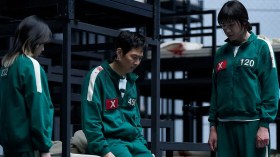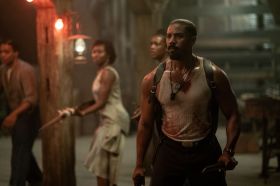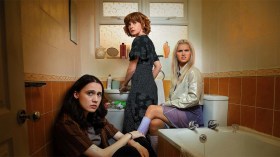In his third adaptation of a work by British playwright Alan Ayckbourn, French director Alain Resnais returns with Life of Riley. Certainly, a bunch of French-speaking characters in the middle of the Yorkshire countryside could be hard to get your head around, but it is Resnais’s bold authorial style that is the beating heart of this quirky, whimsical film.
Resnais undoubtedly brings a distinct visual style in this work, and he pushes the boundaries of theatrical aesthetics with Life of Riley too. From its use of vividly coloured backdrops, fake plants and drapes that act as doors, this film carries a deeply exaggerated theatrical style. The film also uses illustrations by French cartoonist Blutch as a marker for different locations and seasonal changes. There attempted forays into surrealism, with monologues being presented in front of a white patterned backdrop and random appearances of a mole puppet for no explicable reason whatsoever. Unfortunately, Resnais’s two-dimensional style sets quickly feels flat. Its deliberately artificial stage is akin to a cheap sitcom, and perhaps only appeals most to Resnais’s loyal fans.
Life of Riley revolves around three couples whose lives are affected on hearing the news that their mutual friend, George Riley, has been diagnosed with terminal cancer. There’s the vivacious Kathryn (Sabine Azema) and her doctor husband Colin (Hippolyte Girardot), who bicker over the precise time of their unsynchronised grandfather clocks. The wealthy Jack (Michel Vuillermoz) and his wife Tamara (Caroline Silhol) have their own problems with Jack’s infidelities. Kathryn and Tamara decide to invite George into their amateur theatre production, but their time together with George quickly brings old memories to the surface. The last couple of this sextet is George’s estranged wife, Monica (Sandrine Kiberlain), who has since moved in with jealous farmer Simeon (Andre Dussollier).
The actors are charming, and Azema, especially, is a delight to watch in her amusing attempts at hiding her craving for alcohol. However, despite Resnais’s expert direction, strong emphasis on the film’s self-reflexive theatricality results in exaggerated characterisations. The sordid affairs and instances of love won and lost draws closely from a day soap, which can at times be off-putting. The play-within-the-film, for instance, refers to Ayckbourn’s own ‘Relatively Speaking’. Along with George Riley, the play’s demanding director, Peggy, are excruciatingly discussed and referred to by the sextet but never seen onscreen. As a result, Resnais’s venture into dramaturgy onscreen would alienate many viewers, but his experimentation with the medium is undeniably intriguing.
Life of Riley celebrates the artificiality of theatre, all the more transparent onscreen. Resnais sadly passed away in March this year, but from Life of Riley itself, it is clear to see that Resnais never hesitated in playing with the cinematic form.
Rating: 3 stars out of 5
Life of Riley
Director: Alain Resnais
France, 2014, 108 min
Melbourne International Film Festival
www.miff.com.au
31 July – 17 August
Actors:
Director:
Format:
Country:
Release:





